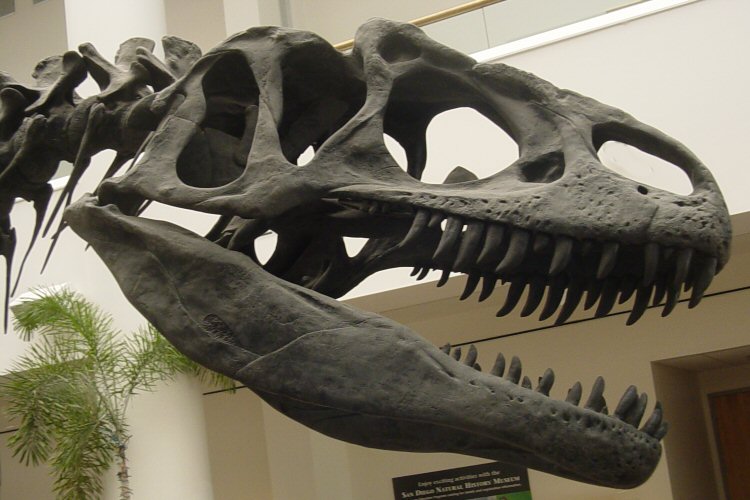- Allosauroidea
Taxobox | name = Allosauroids
fossil_range =Jurassic –Late Cretaceous

image_width = 200px
image_caption = "Allosaurus " skull at the San Diego Natural History Museum.
regnum =Animal ia
phylum = Chordata
classis = Sauropsida
superordo =Dinosaur ia
ordo =Saurischia
subordo =Theropod a
infraordo =Carnosauria
superfamilia = Allosauroidea
superfamilia_authority = Marsh, 1878
subdivision_ranks = Families
subdivision =Allosauridae Carcharodontosauridae Sinraptoridae Allosauroidea is a superfamily or
clade oftheropod dinosaur s which contains three families — theSinraptoridae ,Carcharodontosauridae andAllosauridae . The oldest-known allosauroid, "Sinraptor dongi", appeared in theMiddle Jurassic (Bathonian stage) ofChina , and the latest-known survivors of the family are the carcharodontosaurids of theLate Cretaceous ,Cenomanian stage). Allosauroids had long, narrows skulls, large orbits, three-fingered hands, and usually had "horns" or ornamental crests on their heads. The most famous and best understood allosauroid is theNorth America ngenus "Allosaurus ".ystematics
Taxonomy
*Superfamily Allosauroidea
**Genus "Becklespinax "?
**Genus "Aerosteon " [cite journal |Sereno PC, Martinez RN, Wilson JA, Varricchio DJ, Alcober OA, et al.|year=2008|month=Sept|title=Evidence for Avian Intrathoracic Air Sacs in a New Predatory Dinosaur from Argentina.|journal=PLoS ONE|volume=3|issue=9|pages= e3303|id=doi:10.1371/journal.pone.0003303|url=http://www.plosone.org/article/info%3Adoi%2F10.1371%2Fjournal.pone.0003303|accessdate=2008-09-29]
**FamilyAllosauridae
**FamilyCarcharodontosauridae
**FamilySinraptoridae Phylogeny
The
clade Allosauroidea was originally proposed byPhil Currie and Zhao (1993; p. 2079), and later used as an undefinedstem-based taxon byPaul Sereno (1997). Sereno (1998; p. 64) was the first to provide a stem-based definition for the Allosauroidea, defining the clade as "All neotetanurans closer to "Allosaurus" than toNeornithes ."Kevin Padian (2007) used a node-based definition, defined the Allosauroidea as "Allosaurus", "Sinraptor", theirmost recent common ancestor , and all of its descendants.Thomas R. Holtz and colleagues (2004; p. 100) andPhil Currie andKen Carpenter (2000), among others, have followed this node-based definition. However, in some analyses (such as Currie & Carpenter, 2000), the placement of the carcharodontosaurids relative to the allosaurids and sinraptorids is uncertain, and therefore it is uncertain whether or not they are allosauroids (Currie & Carpenter, 2000).The
cladogram presented here follows the 2000 analysis by Currie and Carpenter.cite_journal |last=Currie |first=Philip J. |authorlink=Phil Currie |coauthors=& Carpenter, Kenneth. |year=2000 |title=A new specimen of "Acrocanthosaurus atokensis" (Theropoda, Dinosauria) from the Lower Cretaceous Antlers Formation (Lower Cretaceous, Aptian) of Oklahoma, USA |journal=Geodiversitas |volume=22 |issue=2 |pages=207–246 |url=http://www.mnhn.fr/publication/geodiv/g00n2a3.html]clade| style=font-size:100%;line-height:80%
label1=Allosauroidea
1=clade
label1=unnamed
1=clade
1="Carcharodontosaurus "
2="Giganotosaurus "
label2=unnamed
2=clade
1="Acrocanthosaurus "
2="Allosaurus "
3=Sinraptoridae References
* Currie, P. J., and X. Zhao. 1993. A new carnosaur (Dinosauria, Theropoda) from the Upper Jurassic of Xinjiang, People's Republic of China. "Canadian Journal of Earth Sciences" 30:2037-2081.
* Holtz, T. R., Jr. and Osmólska H. 2004. Saurischia; pp. 21-24 in D. B. Weishampel, P. Dodson, and H. Osmólska (eds.), "The Dinosauria" (2nd ed.), University of California Press, Berkeley.
* Sereno, P. C. 1997. The origin and evolution of dinosaurs. "Annual Review of Earth and Planetary Sciences" 25:435-489.
* Sereno, P. C. 1998. A rationale for phylogenetic definitions, with application to the higher-level taxonomy of Dinosauria. "Neues Jahrbuch für Geologie und Paläontologie Abhandlungen" 210:41-83.
Wikimedia Foundation. 2010.
